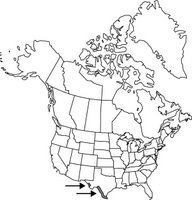Scheidweiler, Bull. Acad. Roy. Sci. Bruxelles. 5: 491, figs. 1-5. 1838.
[The genus Aria and Greek karpos, fruit, referring to the Aria-like fruit]
Allan D. Zimmerman & Bruce D. Parfitt
Neogomesia Castañeda; Roseocactus A. Berger
Plants erect, unbranched [or branched], deep-seated in the substrate [or somewhat subterranean for whole seasons]. Roots taproots. Stem unsegmented, gray-green (yellow-green or purplish with age or stress), above-ground portion flat, concave, or weakly hemispheric, usually flush with soil surface and cryptic, strongly tuberculate, 0-2(-10) × [3-]5-10(-15) cm, hard, rigid, tough skinned [thin skinned in A. agavoides of Mexico]; tubercles arranged in rosettes or mosaics, ± triangular, 8-20[-60] × [3-]11-25 mm, hard, exposed faces of tubercles strongly differentiated from sides [except in some Mexican species], prominently fissured [wrinkled, roughened, or nearly smooth]; areoles elongate [circular and axillary, circular and subapical, or 2-parted], forming a wide woolly groove on each tubercle; areolar glands absent; cortex and pith not mucilaginous, "mucilage" restricted to elongate cavities. Spines absent [sporadic and rudimentary in some Mexican taxa]. Flowers diurnal, borne in axils of tubercles near stem apex, broadly funnelform to almost salverform, 1.5-5 × 1.5-5 cm; outer tepals brownish or greenish with pink tinge, 12-35 × 5-9 mm, margins entire; inner tepals pink or magenta [white or yellow], 13-34 × 4-10 mm, margins entire; ovary smooth (scales, hairs, and spines absent); stigma lobes 5-10, white, 1.2-5 mm. Fruits indehiscent (very rarely explosively dehiscent), white or cream to pale greenish [reddish], spheric to clavate or cylindric, proximally or almost completely buried in copious wool of stem apex, 10-25 × 5-10 mm, initially fleshy, drying and collapsing a few days after ripening, scales and spines absent; pulp white to pale greenish; floral remnant apparently persistent. Seeds black, spheric to obovoid, 1.2-1.6(-2.5) mm, minutely tuberculate, shiny; testa cells strongly convex (conspicuous with lens). x = 11.
Species 6 (1 in the flora): arid regions, sw United States, Mexico.
Ariocarpus species mostly grow in broken rock substrate and closely mimic it. Some Mexican species display additional adaptations, e.g., A. kotschoubeyanus (K. Schumann) K. Schumann withdraws into seasonally inundated, fine lacustrine soil and can be completely buried between growing seasons.
SELECTED REFERENCES Anderson, E. F. 1965. A taxonomic revision of Ariocarpus. Cact. Succ. J. (Los Angeles) 37: 39-49. Anderson, E. F. and W. A. Fitz Maurice. 1997. Ariocarpus revisited. Haseltonia 5: 1-20.
1. Ariocarpus fissuratus (Engelmann) K. Schumann in H. G. A. Engler and K. Prantl, Nat. Pflanzenfam. 106[III,6a]: 195. 1894.
Living-rock cactus, star cactus, chaute, chautle
Mammillaria fissuratus Engelmann, Proc. Amer. Acad. Arts 3: 270. 1856 (as Mamillaria)
Varieties 1-3 (1 in the flora): Texas, Mexico.
1a. Ariocarpus fissuratus (Engelmann) K. Schumann var. fissuratus
 Plants protruding above ground 0-2(-10) cm. Stems: tubercles forming coarse mosaic, closely packed, exposed faces of tubercles deltoid to hemispheric, deeply fissured on either side of central areolar groove, coarsely rugose, often sharply angled apically; areoles to 3 mm wide, sometimes confined to middle of tubercle faces instead of extending to tips. Flowers 2.5-5 cm diam., 2 times wider than long when fully expanded; inner tepals 21-30 × 5.5-7.5(-10) mm.
Plants protruding above ground 0-2(-10) cm. Stems: tubercles forming coarse mosaic, closely packed, exposed faces of tubercles deltoid to hemispheric, deeply fissured on either side of central areolar groove, coarsely rugose, often sharply angled apically; areoles to 3 mm wide, sometimes confined to middle of tubercle faces instead of extending to tips. Flowers 2.5-5 cm diam., 2 times wider than long when fully expanded; inner tepals 21-30 × 5.5-7.5(-10) mm.
Flowering Sep-Nov. Chihuahuan desert scrub, low, rocky hills of limestone chips; 500-1500 m; Tex.; Mexico (Chihuahua, Coahuila, Durango).
The stems of Ariocarpus fissuratus are normally flush with the soil surface and resemble limestone chips in shape, color, and texture, rendering the plants extremely cryptic. The species is often found growing with Agave lechuguilla and species of Leucophyllum, and Parthenium.

Back to online articles.
The Flora of North America web site.



















No comments:
Post a Comment